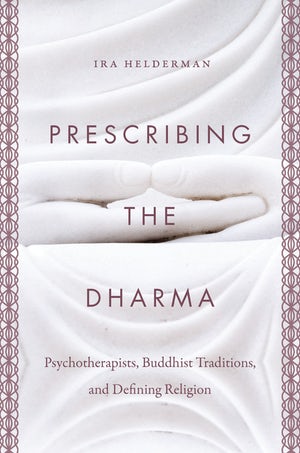 William James may have been the first psychologist to take an interest in Buddhism, but he certainly was not the last. In Prescribing the Dharma: Psychotherapists, Buddhist Traditions, and Defining Religion (University of North Carolina Press, 2019), psychotherapist and religious studies scholar Ira Helderman explores the history and current status of the ongoing relationship between the American psychotherapeutic community and Buddhist traditions—at least the Buddhist traditions as transmitted by Asian modernizers and as practiced within predominantly European-descent Buddhist ”convert” communities. His approach is based both on a participant-observer ethnological analysis (he attends professional psychological conferences devoted to Buddhist themes and interviews presenters and attendees) and on textual analyses of the writings of major figures, living and historical, who have played key roles in the unfolding relationship between Buddhism and Western psychology.
William James may have been the first psychologist to take an interest in Buddhism, but he certainly was not the last. In Prescribing the Dharma: Psychotherapists, Buddhist Traditions, and Defining Religion (University of North Carolina Press, 2019), psychotherapist and religious studies scholar Ira Helderman explores the history and current status of the ongoing relationship between the American psychotherapeutic community and Buddhist traditions—at least the Buddhist traditions as transmitted by Asian modernizers and as practiced within predominantly European-descent Buddhist ”convert” communities. His approach is based both on a participant-observer ethnological analysis (he attends professional psychological conferences devoted to Buddhist themes and interviews presenters and attendees) and on textual analyses of the writings of major figures, living and historical, who have played key roles in the unfolding relationship between Buddhism and Western psychology.
His is not a straightforward story either of the secularization, subversion, and cultural appropriation of Buddhist tradition by therapists, or of the stealth transmission of Buddhist ideas into American culture. As Helderman points out, ”psychotherapy” and ”Buddhism” are socially constructed categories and, therefore, are not entities that can engage in dialogue. There are only individual clinicians making pragmatic decisions about how to treat individual clients while negotiating the boundaries set by organizations and agencies that police their profession and responding to the influences of multiple impinging historical and cultural forces and professional imperatives. These clinicians often occupy multiple and somewhat conflicting roles as scientists, healers, and religious practitioners. They need to negotiate a variety of socially constructed categories that necessarily inform their decisions, including the definitional categories of religion, secularity, spirituality, science, medicine, and therapy, and what the relationship between these categories ought to be. They also need to consider the essential aims of both therapy and Buddhist practice—whether they are consonant or disparate—and their relationship to more broadly construed conceptions of ”wellness” and ”the good life.”
Helderman defines six major approaches clinicians take with regard to Buddhism: therapizing, filtering, translating, personalizing, adopting, and integrating. In the chapters that follow the introductory chapters, Helderman examines each of these approaches and the work of psychotherapists who typify each approach. At the same time, he is clear that these approaches are not pure types and that the clinicians he reads and talks to often adopt multiple and, at times, conflicting approaches, sometimes emphasizing different approaches depending on the audience they are addressing. Therapizing means explicating Buddhism in the language of psychological discourse, as when Franz Alexander explicates the goal of Buddhist practice as a narcissistic rechanneling of libidinal energies away from the external world and onto the self. Filtering involves picking and choosing Buddhist ideas according to how consonant they are with modern Western science. Therapizers and filterers both view psychology and science as the final arbiters of truth. Translating involves restating Buddhist practices in biomedical terms, as when meditation is described as ”attentional training practice” or ”the relaxation response.” Personalizing involves a private personal commitment to Buddhism, while keeping it in a separate silo from one’s clinical practice. Adopting means reformulating psychotherapy in Buddhist terms. Adopters see Buddhism as the final arbiter of truth. Finally, integrating involves finding ways Buddhist and psychotherapeutic ideas can mutually assimilate and accommodate to each other, where neither is seen as being necessarily privileged over the other. As Helderman reviews these approaches, he explores the work of such clinicians and theorists as Carl Jung, Franz Alexander, Abraham Maslow, Erich Fromm, Karen Horney, Jon Kabat-Zinn, Jeffrey Rubin, Polly Young-Eisendrath, Barry Magid, Steve Hayes, Mark Epstein, Marsha Linehan, Paul Cooper, Harvey Aronson, Paul Fulton, Jack Engler, Jack Kornfeld, Joseph Loizzo, Pilar Jennings, Jan Surrey, Jeremy Safran, Christopher Germer, Gay Watson, Karen Kissel Wegela, Ken Wilber, and others.
Many of the clinicians described are unhappy with the conventional boundaries of what constitutes religion and what constitutes secularity. They often try to redefine the terms or blur their boundaries, but their influence is inescapable. Helderman explains this is the case because of the pervasive influence of training and certification authorities, third-party payors, hospital accreditation organizations, first amendment considerations, and malpractice case law; the long cultural history of how ideas are transmitted to us; clinicians’ self-identifications with their own therapeutic lineages and the internalization of their norms; and religious scholars’ critiques, which, for clinicians, often help define the authenticity of their understandings of Buddhist teachings. Helderman argues that the boundaries clinicians redraw between what is religious, secular, spiritual, medical, and psychotherapeutic are inherently unstable and riddled with internal inconsistencies, and thus subject to constant critique and revision.
Helderman views clinicians’ relationship with Buddhism against the larger background of what Eugene Taylor has called psychology’s ”shadow culture” (Shadow Culture: Psychology and Spirituality in America [1999]). While American psychology is often trifurcated into the three twentieth-century mainstreams of psychoanalysis, behaviorism, and humanistic psychology, Taylor described a ”fourth stream” of alternative healing methods from Swedenborgianism, homeopathy, mesmerism, Christian Science, and New Thought, down to today’s mindfulness. Taylor described how this fourth stream periodically emerges, is repressed, and then makes an inevitable return because the division between scientific/medical and religious/spiritual aspects of healing is always unstable. Are Buddhist-oriented psychologists mixing science and religion? Or if psychotherapy is a substitute for the religious dimension of life in a secularized age, are therapists really mixing two different types of spiritual traditions? Psychotherapists have always occupied a kind of liminal space between science, art, medicine, and spirituality, and Buddhism—or at least Western Buddhist modernism—can be seen as the newest import into this space.
Helderman is primarily a religious studies scholar, and he makes good use of both religious studies broadly considered and modern Buddhist scholarship in particular. One theme he revisits a number of times is the degree to which modern Western psychotherapists’ usage and understanding of Buddhism can be compared to the process of sinicization and the way the medieval Chinese understood and made sense of Buddhism. This is, of course, a claim that Buddhist-oriented psychologists make themselves in order to help legitimate their work. Is Buddhism, like the fabled Ship of Theseus, something that undergoes constant transformation yet remains, somehow, the same ship, or at some point is it no longer Buddhism? Are karma, reincarnation, merit-making, and celestial bodhisattvas necessary parts of any Buddhism, or can a Buddhism without them still be a Buddhism? Who gets to decide whether something is still a form of Buddhism, or whether it is crypto-Buddhism or simply New Age nonsense? These are questions Helderman raises, presenting arguments on both sides, but leaves essentially unresolved. Helderman emphasizes that these questions are not mere idle questions. There is something important at stake here. At the heart of these disputes is a clinician struggling with how best to help a seriously disturbed patient who has not been helped by the usual and customary therapeutic measures—a therapist who, in the midst of uncertainty and controversy, must make a decision about whether and how to make use of something he learned at a conference, in a zendo, or from a book that he thinks might be helpful but is not sure will be universally applauded. Helderman thinks we ought to have some real sympathy for this clinician, but he also thinks that in order to do their work well, clinicians need to formulate and clarify their own considered answers as to what is health and well-being, what kind of endeavor therapy is, and to what degree religion can and ought to be included in this mix.
Helderman has written a book that is admirable in terms of its comprehensiveness, depth, and nuance. The clinicians included in this study are a good representation of thought leaders—psychoanalytic, cognitive-behavioral, and humanistic/transpersonal—in the field. His historical coverage of seminal figures, such as Jung, Alexander, Maslow, and Fromm, is excellent. He makes good use of the work of contemporary Buddhist scholars, such as Stephen Bokenkamp, JosÁ© CabezÁ³n, Francisca Cho, Rupert Gethin, Jay Garfield, Luis Gomez, Janet Gyatso, Donald Lopez Jr., David McMahan, John McRae, Ann Gleig, Robert Campany, and Robert Sharf, among many others, as well as scholars of contemporary religion and spirituality. Helderman’s book is the most accurate, complete, and in-depth exploration of how Western psychotherapists therapize, filter, translate, personalize, adopt, and integrate Buddhism into their theories, lives, and practices yet written, and is likely to remain a classic for years to come. It has implications not only for how clinicians construe their practice but also in understanding the largest vector for either (depending on one’s viewpoint) the transmission of Buddhism into American culture or its secularization and diminishment.
This review is republished by the author from H-Buddhism, H-Net Reviews. October, 2020. URL: http://www.h-net.org/reviews/showrev.php?id=55545
